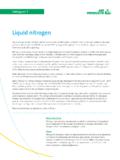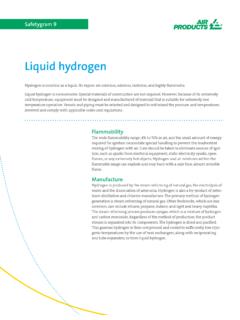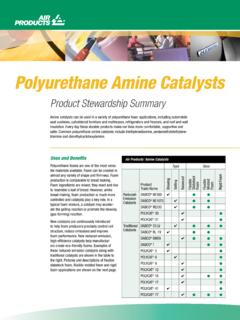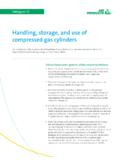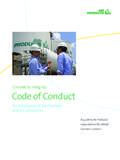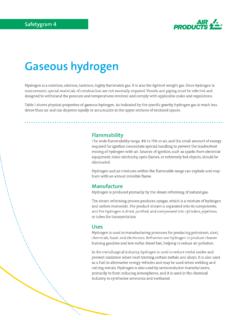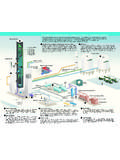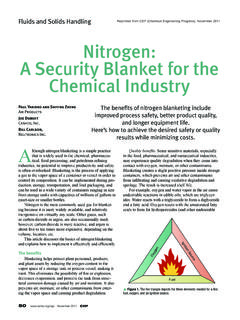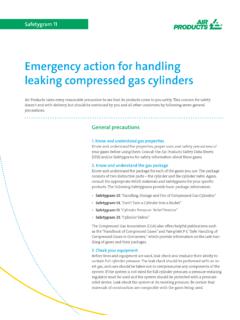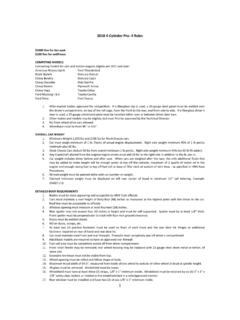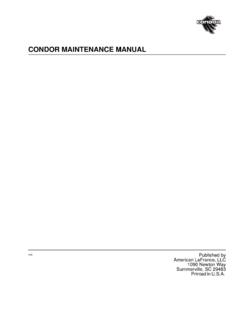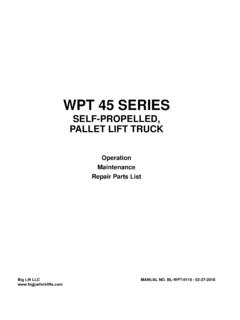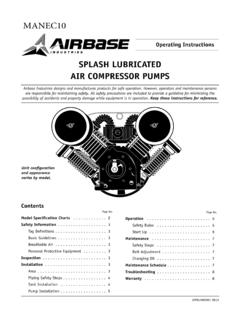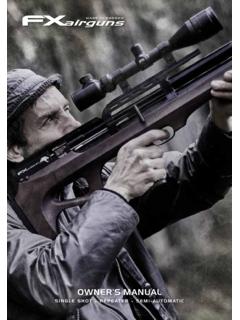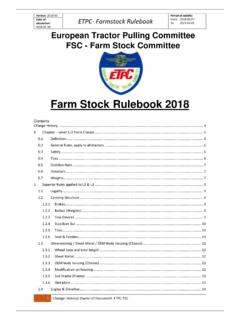Transcription of Cylinder valves - Air Products & Chemicals
1 Most compressed gas cylinders require the installation of at least one valve. This valve allows the Cylinder to contain gases and allows gas to be filled into or emptied from the Cylinder . The Cylinder valve is the most vulnerable part of the compressed gas package and requires a thorough understanding to maximize its performance. There are four basic valve types: the pressure seal valve, the packed valve, the O ring valve, and the diaphragm valve. There are several ver sions or designs within each of the four basic types. This pamphlet will address the more common valves in today s working knowledge of Cylinder valves can improve processes, save time and money, prevent problems, maintain the life and integrity of the valve, and improve the safety of your operation. This document must not be used as a guide for valve modification or repair.
2 No modifications to valves are permitted, and any repairs shall only be made by or under direction of the valvesBasic valve rules Always open valves slowly to control pressure surges and heat of compression use the correct outlet connection for hook up inspect the valve for damage and foreign materials before connecting it to your equipment completely close the valve and keep the valve outlet seals and transporation cap securely in place when not in use. use the proper equipment to move cylinders. move cylinders with the transportation cap in place. consult your supplier if you have any questions regarding Cylinder valvesImportantWhen returning any Cylinder , ensure that the Cylinder valve is properly closed, any outlet seals are in place and properly tightened, and the transport cap is correctly installed.
3 Never tamper with pressure relief devices attempt to tighten or loosen the valve into or out of the Cylinder use a damaged valve where integrity may have been affected lubricate valves or their connections drag, lift, or move a Cylinder using the valve or the hand wheel as a handle remove packing nuts on packed valves adjust or tamper with gland or bonnet nuts on diaphragm, pressure seal or O ring valves use the Cylinder valve to regulate flow or pressure interchange transport caps between cylindersSafetygram 23 consult your supplier before using an automatic operator, adapter, wrenches, or other tools to obtain a mechanical advantage on handwheel operated valves . Discontinue using a valve that operates abnormally, , becomes noisy or progressively harder to 1A: Pressure Seal ValveFigure 1b: O Ring ValveSpring AssemblyHandwheelHandwheelBonnetGland (Bonnet) NutPackingO ring(s)Upper StemUpper StemLower StemLower StemPressure Relief DeviceSeat InsertSeat InsertValve BodyValve BodyPressure seal valve (Figure 1A) Products : inerts, oxygen, hydrogenOperating principle: The pressure seal valve is a handwheel operated valve using a two piece valve stem.
4 The upper and lower stems interface with each other. The threads are located on the lower stem, and the upper stem is free floating. A Teflon material packing ring that makes contact with a ridge on the upper stem provides the seal around the valve stem. The force that provides this contact is gas pressure and the spring located in the handwheel. This spring provides upward force to the upper stem and pulls the stem s sealing ridge into the packing ring. Identifying features1. A spring in the handwheel can be detected by wiggling the hand wheel. If a spring is present, the handwheel will pivot on the The valve has a nonrising hand wheel. The handwheel is always in the same position relative to the valve body, regardless of whether the valve is in the open or closed opening procedure: Air Products recommends pressure seal valves be used in the fully open or backseated position.
5 Opening the valve fully causes the lower stem to ride upward on its threads until it contacts the upper stem and mechani cally drives the upper stem s seal ridge into the packing ring. This improves the seal around the stem and helps to prevent packing leaks. valves in the backseated position can be mistaken as closed by inexperienced or un trained operators. When an operator checks a valve to ensure its position, he should always check by attempting O ring valve (Figure 1B) Products : inerts, oxygen, hydrogenOperating principle: The O ring valve is similar in design to the pressure seal valve, except that for the upper stem, the sealing is achieved by O rings(s) instead of a features1. There is no spring required in the design and so there is no wriggle to the handwheel. The handwheel does not rise due to handwheel rotation position, but the user can sense a rise of the handwheel, when the valve is initially opened and the gland area subject to high opening procedure: The valve does not require to be back seated during close the valve, never by trying to open the valve.
6 If the valve was back seated using substantial effort, it is possible that the operator could think the valve is closed, when in fact it is fully open. Operators must be trained to use pressure readings or an equally reliable indicator to ensure that the Cylinder valve is closed or closing procedure: Close the Cylinder valve tightly using a gloved hand. Air Products recom mends always wearing gloves when operating Cylinder valves . NEVER use wrenches or other mechanical devices to operate the valve. Valve advantages: The pressure seal valve is extremely reliable, very strong (used at pressures up to 6000 psig), economical, and user friendly. Valve disadvantages: The valve is prone to gland leakage around the stem, especially when a vacuum is pulled on the valve outlet. Backseating helps minimize gland leakage when the valve is in the open position.
7 The threads on the lower valve stem are in the wetted gas stream. These threads are lubricated, and these lubricants can be an unwanted contaminant in high purity applications. Comments: This is a very reliable valve for noncorrosive Products . However, the design makes this valve inappropriate for corrosives and ultrahigh purity Products . Note: Teflon is a registered trademark of du Pont de Nemours and wrench-operated packed valve (Figure 2) Products : corrosives and reactive gasesOperating principle: The wrench operated valve is a packed valve with a one piece stem. The seat to stem seal is a metal to metal seal. The man ufacturer s minimum recommended closing torque is 35 ft lbs. This is much more than can be applied with hand force; therefore, the valve requires a wrench to provide sufficient closing force. The stem seal is accomplished by compressing a large ring of Teflon material between the valve body and packing nut, which forces the Teflon material to grip the features1.
8 This valve does not have a hand wheel. The top of the stem is machined square to accommo date a The top of the valve has a large, internal threaded nut screwed onto the body, where the valve s stem exits. This is the packing nut. Recommended opening procedure: The wrench operated valve has a very large flow capacity. It is not necessary to open this valve to the full open position to provide full flow to the process. Opening this valve fully pose serious problems. The first problem is safety related. In many applications, cylinders with these valves are used in tight quarters ( , gas cabinets) or behind barricades. These space constraints often prohibit the stem from being fully rotated when the valve is operating. This valve requires approximately three full turns from full open to full close. In the case of an emergency, it can take 15 to 30 sec onds to close the valve, depending on space and operator stress.
9 However, if the valve is opened to the recom mended to turn, the valve can be quickly closed with minimal operator exposure. The second benefit of only opening the valve the recommended to turn is the protection of the up Valve StemPacking NutPacking FollowerPackingValve BodyValve SeatPressure Relief DeviceFigure 2: Wrench-Operated Packed Valveper section of threads are in the wetted gas stream, and due to the corrosive nature of many of the Products where these valves are used, the threads can become jammed with corrosion by Products . If the valve is opened to the recommended to turn and the threads become jammed, the upper threads usually remain clear. This allows the operator to further open the valve and to free the threads. The proper operation of this valve requires the use of a suitable square stem wrench (T bar).
10 This wrench has a square hole sized to fit the stem and an open end wrench on the opposite end that fits the packing nut. The Air Products recommended opening pro cedure for this valve is as follows:1. Connect the Cylinder to the Snug the packing nut with the wrench (35 ft lbs).3. Place the wrench on the stem and slap the valve open by striking the wrench with the palm of the Continue opening the valve until it is to turn open. Where possible, leave the wrench on the valve so that a quick closing of the valve can be done in the event of an closing procedure: Tighten the stem by pulling the wrench to the closed position. When the valve is closed as tightly as the wrench can be pulled, give the wrench a closing slap with the gloved palm of the hand. The minimum closing torque for this valve is 35 ft lbs, but it is not uncommon for some valves to require as much as 60 to 80 ft lbs to fully seal.
